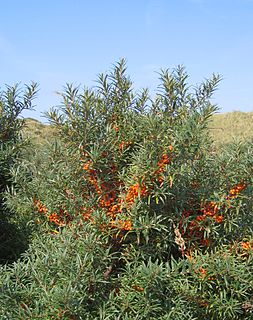
Hippophae is the genus of sea buckthorns, deciduous shrubs in the family Elaeagnaceae. The name sea buckthorn may be hyphenated to avoid confusion with the unrelated true buckthorns. It is also referred to as sandthorn, sallowthorn, or seaberry. It produces orange-yellow berries, which have been used over centuries as food, traditional medicine, and skin treatment in Mongolia, Russia, and northern Europe, which are its origin regions.

Niemeyera is a genus of plants in the family Sapotaceae described as a genus in 1870. The entire genus is endemic to Australia. Its closest relative is Pycnandra from New Caledonia.
- Niemeyera chartacea(F.M.Bailey) C.T.White - Queensland
- Niemeyera prunifera(F.Muell.) F.Muell. - Queensland
- Niemeyera whitei(Aubrév.) Jessup - Queensland, New South Wales
Planchonella kaalaensis is a species of plant in the family Sapotaceae. It is endemic to New Caledonia.
Pycnandra is a genus of trees in the family Sapotaceae described as a genus in 1876.

Pouteria australis, also known by the synonym Planchonella australis, is a medium to tall rainforest tree of the family Sapotaceae native to Queensland and New South Wales, Australia. It is known by the common name black apple, wild plum, yellow buttonwood, black plum and yellow bulletwood.
Planchonella is a genus of flowering trees in the gutta-percha family, Sapotaceae. Named in honour of Jules Émile Planchon, it contains around 100 mainly tropical species, two of which occur in South America and about 18 in Australasia. It was described by Jean Baptiste Louis Pierre. The genus is included in the larger genus Pouteria by some authorities, hence species such as Planchonella queenslandica are also known as Pouteria queenslandica.

Pouteria myrsinoides is an Australian tree in the family Sapotaceae. The common names include yellow plumwood, axe-handle wood and blunt-leaved coondoo. It occurs in seaside rainforests and drier rainforests from the Forster, New South Wales to the Lakeland Downs in tropical Queensland. The subspecies reticulata occurs on Lord Howe Island and in New Caledonia.

Chrysophyllum imperiale is a tropical tree of the family Sapotaceae native to eastern South America. It is currently classified as an endangered species.

Chrysophyllum oliviforme, commonly known as the satinleaf, is a medium-sized tree native to Florida, the Bahamas, the Greater Antilles, and Belize. It is also known as Damson plum, wild star-apple, saffron-tree, Caimitillo, Caimitillo de Perro, Camitillo Cimarró, Teta de Burra, Macanabo, and Caïmite Marron. It gets the name satinleaf from the distinctive colors of the leaves. The top of the leaf is dark green while the bottom is light brown or copper. This distinctive look makes it a very aesthetically pleasing tree that is commonly used as an ornamental in yards and public spaces.
Pichonia is a group of trees in the Sapotaceae described as a genus in 1890.

Sersalisia is a genus of trees in the family Sapotaceae described as a genus in 1810.
Planchonella rufocostata is a species of plant in the family Sapotaceae. It is endemic to New Caledonia. As with other species in the same genus, it possesses stamens that are located below the tube orifice; a multi-seeded fruit, as well as foliaceous cotyledons embedded in endosperm.
Planchonella roseoloba is a species of plant in the family Sapotaceae. It is endemic to New Caledonia. As with other species in the same genus, it possesses stamens that are located below the tube orifice; a multi-seeded fruit, as well as foliaceous cotyledons embedded in endosperm.
Planchonella povilana is a species of plant in the family Sapotaceae. It is endemic to New Caledonia. As with other species in the same genus, it possesses stamens that are located below the tube orifice; a multi-seeded fruit, as well as foliaceous cotyledons embedded in endosperm.
Planchonella mandjeliana is a species of plant in the family Sapotaceae. It is endemic to New Caledonia. As with other species in the same genus, it possesses stamens that are located below the tube orifice; a multi-seeded fruit, as well as foliaceous cotyledons embedded in endosperm.
Planchonella luteocostata is a species of plant in the family Sapotaceae. It is endemic to New Caledonia. As with other plants in the same genus, it possesses stamens that are located below the tube orifice; a multi-seeded fruit, as well as foliaceous cotyledons embedded in endosperm.
Planchonella latihila is a species of plant in the family Sapotaceae. It is endemic to New Caledonia. As with other plants in the same genus, it possesses stamens that are located below the tube orifice; a multi-seeded fruit, as well as foliaceous cotyledons embedded in endosperm.
Planchonella crenata is a species of plant in the family Sapotaceae. It is endemic to New Caledonia. As with other species in the same genus, it possesses stamens that are located below the tube orifice; a multi-seeded fruit, as well as foliaceous cotyledons embedded in endosperm.

Pycnandra acuminata is a species of plant in the family Sapotaceae. It is a rainforest shrub, endemic to New Caledonia, and is adapted to the nickel-rich ultramafic soils found there. Pycnandra acuminata is notable as one of the most prolific hyperaccumulators of trace metals known, actively absorbing nickel from the soil and concentrating it within the plant to a concentration of up to 25% nickel citrate as dry weight of the sap, which is blue in colour due to the nickel content. The vernacular name in French is sève bleue.







